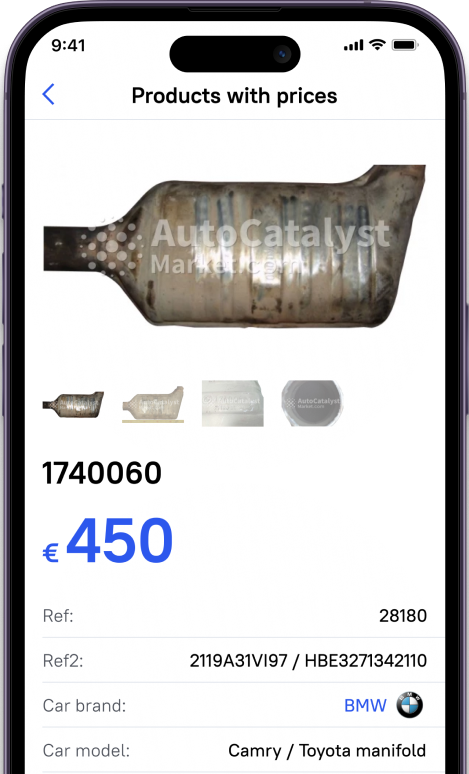- Flushing the catalytic converter with special fluids may be most effective for:
- Car repair specialists practice the following cleaning options for catalysts:
- The catalyst washing has the following steps:
- Mechanical method
- This work is carried out in the following sequence:
- Tips & Tricks
Catalyst in a modern car is necessary to reduce exhaust emissions. This part has a limited resource, so over time it becomes necessary to replace and clean it. Catalyst, regardless of car model, is quite expensive. For this reason, many drivers are wondering how to clean the detail without replacing it.
The unit is similar to resonator tank. Catalyst is a container with two connecting nozzles. Inside there are small ceramic honeycombs coated with a catalytic layer based on noble metals (hence the high price of spare parts). Exhaust flue gases clog the cells with soot, gradually making the neutralizer impassable.
The option without dismantling is a priority for vehicle owners, because on many cars this part can be removed only by cutting the grinder from the exhaust gas system.
Can DIY catalyst cleaning be effective?
Before proceeding with actions, it is necessary to find out in which cases catalyst cleaning can bring benefit.
Flushing the catalytic converter with special fluids may be most effective for:
-
Implementation of preventive measures.
-
Strong clogging of catalyst honeycomb with soot.
-
If the detail has not yet failed, but a slight decrease in engine power and an increase in fuel consumption is already observed. In order to extend the service life, chemical cleaning is performed.
-
With a strong blockage of honeycombs, but in absence of reflows, this method allows to significantly extend the life of catalyst. It increases engine power and reduce fuel consumption.
Car repair specialists practice the following cleaning options for catalysts:
-
Preventative cleaning with a detergent.
-
Repeated washing.
-
Mechanical cleaning.
Preventive catalyst cleaning, as a rule, is carried out with a mileage of 70 - 80 thousand km. This method allows you to resolve the problem without dismantling the part.
Repeated washing is used to clean a heavily soiled catalytic converter. In order to clean it in this way, you will need to disassemble a part of the exhaust system of a car.
Mechanical cleaning is carried out using a compressor and a brush. This option for cleaning the catalyst is also performed on dismantled section of exhaust pipe.
The catalyst washing has the following steps:
-
Catalyst is removed and subjected to strict control. If honeycombs are not destroyed, and the device is considered in good conditions, a manual wash is performed.
-
Hot water is turned on under pressure, the catalyst is pressed down with something heavy (but not excessive, just so that it does not fly away, and the honeycomb is not damaged at the same time) and is washed for 2 minutes from each side.
-
Rinse the catalyst at home over a porcelain sink, but not over the bathroom (it destroys enamel or acrylic) and not over the kitchen sink (washable chemistry will corrode it).
-
Get the catalyst dry.
-
A sign of a successful completion of work will be clean honeycombs. If there is too much dirt on a catalyst, after the first treatment, it should be left overnight in kerosene or diesel fuel, which is easier to get.
-
Re-treatment and washing are carried out.
The need for mechanical catalyst cleaning arises when it is not possible to remove contamination by washing the part.
Mechanical method
This work is carried out in the following sequence:
-
Catalytic converter is removed from the exhaust system of a car.
-
Contaminated honeycombs are cleaned gently with fine sandpaper.
-
Catalyst is purged with compressed air.
The mechanical method proved especially good when cleaning catalysts of diesel engines. This part is very dirty in such cars, so with a careful approach, you can restore the throughput of the product.
Work should be done very carefully so as not to damage the inside of a unit, which is made of special ceramics.
Tips & Tricks
If after adding the additive to gasoline it was not possible to restore the catalyst, then you can not do it without disassembling the exhaust system. If the method of mechanical cleaning with your own hands for one reason or another cannot be performed, then you can try to rinse with a special liquid to clean the catalysts.
Before cleaning the catalyst, make sure that its internal parts are not deformed. If as a result of the check significant areas with melted honeycombs are revealed, a complete replacement of catalyst will be required.
In order to save money and time, drivers often abandon the idea of cleaning and replacing this important autopart, punching new holes in it, or drilling them. This decision will allow you to return the engine power, but the car will probably start emission harmful gas into the atmosphere. In addition, the noise level from the exhaust pipe that occurs when the car is moving will increase. Such methods of “cleaning” are unacceptable, and during the long-term operation of an engine with a damaged filter element, various problems can arise.
Despite recommendations of complete removal of catalyst from the exhaust system of a car by many garage masters, this is not worth it. The absence of a catalyst significantly increases the toxicity of products resulting from the combustion of automotive fuel.








































